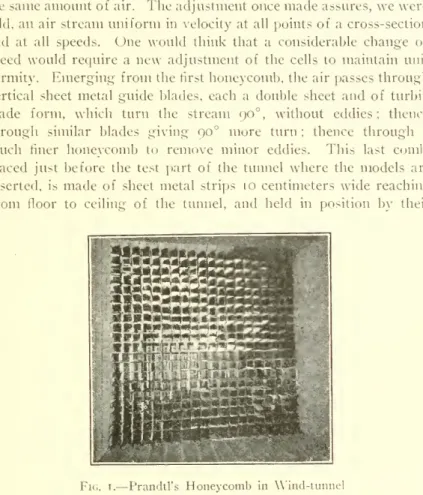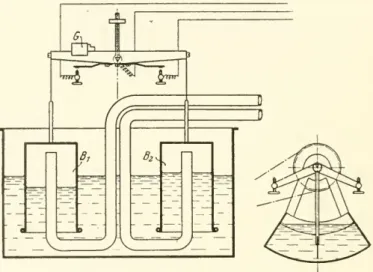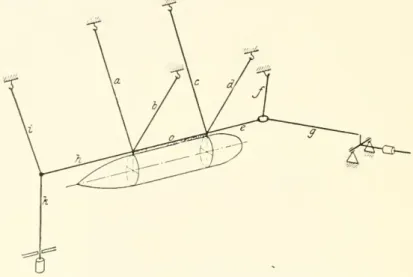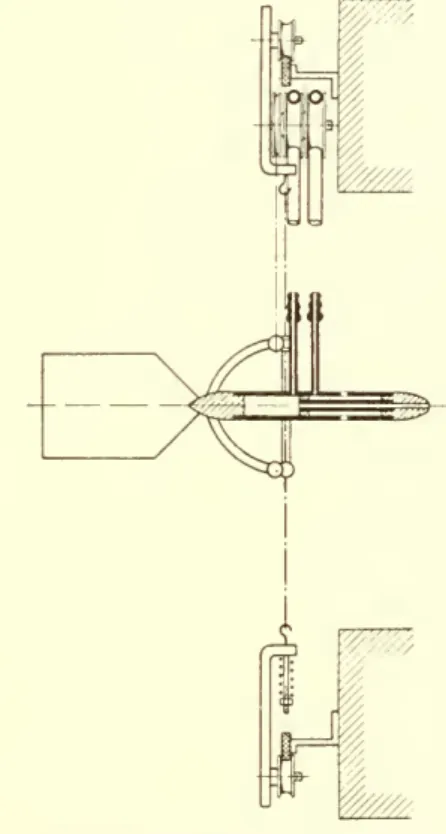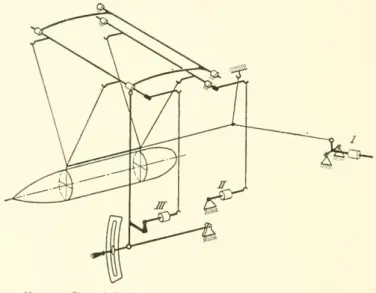The director general of the laboratory is Eiffel himself .. who initiates the investigations and publishes the results. The work in the laboratory is all indoors and is limited to research in flight engineering alone, or more specifically to wind tunnel measurements and reports thereof. The enterprise was inaugurated on a small scale owing to the uncertainty at that time as to the practical value of such an establishment.
The part of the National Physical Laboratory devoted exclusively to aeronautics consists of the swing table house, the large wind tunnel house and the small wind tunnel house with its free space for small apparatus. Its larger end juts against the end wall of the room, while its mouth stops far short of the opposite end. The complete structure of the tunnel need not be delineated here, as it may be better drawn from the general plans and detailed working drawings which the Director of the Laboratory has kindly offered to supply the Smithsonian Institution.
The speed of the air flow in the uncontrolled flow, near the model kept inside the tunnel, is calculated from the observed pressure difference between the inside and the outside of the tunnel wall. The accuracy of this method was experimentally proved by me in 1902 at the request of the Navy Department, and together with a mathematical proof it was set forth in the Physical Rcviczu the following year. Therefore, the average flow velocity through the space is 4 percent of the velocity through the tunnel.
Thus, one arm of the U-tube can be connected to the inner surface of the tunnel, while the other arm is connected successively to different points on the surface of a model.
NO. 3 EUROPEAN AERONAUTICAL LABORATORIES — ZAHM Q
Wind tozvers.— On the ground west of the National Physical Laboratory buildings, two wind towers, each 60 feet high and provided with rotating platforms 20 feet long, are used to determine the flow and pressure of free air about large-scale models. results of such determinations have been published. by Dr. Stanton in the proceedings of the Institution of Civil Engineers for 1907, and later studies may be found in the reports of the Advisory Committee. The Smithsonian Institution could no doubt obtain a similar service from the three tall radio towers in its vicinity. The Royal Air Craft Factory, headed by Mr. Mervin O'Gorman, member of the Advisory Committee, is adjacent to the headquarters and airfields of the Military Wing/ at South Farnborough.
Its work is coordinated with the aeronautical research of the National Physical Laboratory, and is professedly concerned with the scientific improvement of aircraft construction, although in reality it is sometimes directed to the manufacture, on a large scale, of aircraft, propellers and components. of airships. Plant construction and research are under the direction of a civilian staff, which works with the Advisory Committee on Aviation in performing aeronautical engineering work for the naval and military branches of the air service. The close coordination of the Air Craft Factory with the Flying Corps and with the Advisory Committee is a clear advantage for the advancement of aeronautical engineering, which could be further improved if all experimental sites were located in one place, as proposed for the L ^nited. States.
Both have a revolving table; both have an engine test facility; both have studied the building materials; both design instruments. Broadly speaking, the laboratory examines models; factory full-scale aircraft, their parts and accessories. The Aviation Advisory Committee is an independent body appointed by the Prime Minister and which receives its funding directly from the Minister of Finance.
NO. 3 EUROPEAN AERONAUTICAL LABORATORIES ZAHM II
12 SMITHSONIAN MISCELLANEOUS COLLECTIONS VOL. 62
FRENCH AERONAUTICAL LABORATORIES
NO. 3 EUROPEAN AERONAUTICAL LABORATORIES ZAHM I3
14 SMITHSONIAN MISCELLANEOUS COLLECTIONS VOL. 62
MUSS
In the central hall, experimental devices dedicated to the study of air phenomena will be installed, including a large fan with a diameter of 1.80 meters and an aerodynamic balance, with which the pressure of an aircraft on surfaces of different shapes will be determined. There will also be air chambers supplied by another fan and in which it will be possible to measure the strength, center of pressure, components and result of the reaction of an air flow with a speed of up to 20 meters per second. In the chemical laboratory the study of light gases, suitable for balloon work, will be continued, and questions relating to their manufacture, purification, properties, etc., will be investigated.
The chemical properties of various wrapping materials, the changes that occur in them under the influence of heat, light and moisture, the properties and characteristics of various varnishes applied to the material from the air and to preserve it, and similar subjects will be studied. also the best. The workshop will enable the production and repair of all experimental equipment required by the institution. In the powerhouse, located at the west end of the building, are two vertically compound steam engines directly connected to dynamos that supply power and light for the entire institute.
At the terminus a slope of half this amount, but extending for about 500 feet, has been provided to facilitate stopping and returning the carriage. An electrical conductor is laid on each side of the line and along its entire length, through which power is supplied to the car's motor. The use of four carriages was chosen because each series of experiments requires a different carriage equipment and a different recording device.
It is also essential that each vehicle is specifically designed to meet the conditions of the specific class of experiments for which it is intended. According to current intentions, the first cart will be used to measure the horizontal and vertical components and the resultant of air pressure on supporting surfaces, whether flat or curved, simple or composite. The determination of the direction of the resulting, the center of pressure, its displacement and the angle of incidence.
The fourth carriage will be specially equipped to measure the resistance or "'drift'" of the various parts of a flying machine. The weight of the first wagon is about three and three-quarter tons, excluding the car, and a little less than five tons with the car. The body of the wagon is constructed of steel plates stiffened with angle irons and measures twenty feet long and six feet six inches between the longitudinal members of the frame.
A chronograph records the number of revolutions of the wheels in a certain time, from which the speed is derived. In addition, there will be a direct speedometer that registers the value of ds/dt at any time during the journey.
NO. 3 EUROPEAN AERONAUTICAL LABORATORIES ZAIIM \J
Using cars on a smooth road, Chauviere tested screw propellers mounted above the vehicle and advancing at natural operating speeds, and the Due de Guiche measured the lift, power.
GERMAN AERONAUTICAL LABORATORIES
NO. 3 EUROPEAN AERONAUTICAL LABORATORIES — ZAHM 19
20 SMITHSONIAN MISCELLANEOUS COLLECTIONS VOL. 62
NO. 3 EUROPEAN AERONAUTICAL LABORATORIES ZAH M
22 SMITHSONIAN MISCELLANEOUS COLLECTIONS VOL. 62
XO. 3 EUROPEAN AERONAUTICAL LABORATORIES ZAHM 2T,
CONCLUSION
